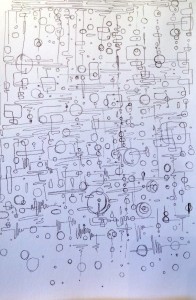 On scraps of paper. In the margins. Over leaflets. In meetings. In waiting rooms. In trains.
On scraps of paper. In the margins. Over leaflets. In meetings. In waiting rooms. In trains.
In lectures. In seminars
When we are waiting or listening, many of us doodle. Forming, re-forming and editing the lines, shapes and flourishes. But how do you feel when you glimpse students’ doodles during your riveting lecture or seminar? Around the written text are scribbles and swirls, triangles and tangents which merge and coalesce. But these images are also text.
In the past, when colleagues commented on my doodles, I felt spied upon and embarrassed. Even if complimentary, there was tacit understanding that doodling was a childish, meaningless and redundant activity. To doodle in the Oxford English Dictionary is to “to draw or scrawl aimlessly”. As a drawing researcher interested in mark-making for exploratory thinking, this cursory definition does not sit well.
Doodling is engaging, immersive and experimental. Though these generative drawings, made with everyday paper and pen, may not be explicitly meaningful to others they are certainly not meaningless. In her 5 minute TED talk, Sunni Brown promotes doodling as spontaneous mark-making processes that help us think. Free form drawing-in-the-moment is a counterpart to designerly thinking sketches used by designers, artists and architects to work through complexities. An extension of this is sketch-noting, a form of visual note taking that appreciates both writing and image.
What do you doodle in your notebook, meeting notes or envelope scrapes? Ruth Rostron, the vice-chair of the British Institute of Graphologists, suggests that attending to the character of the drawn line, the shapes, spatial arrangements and colours might be revelatory. Doodling helps people memorise tedious information and exhibit an integrated understanding from auditory information, such as within lectures or meetings.
Things are different now: I sketchnote and doodle contentedly in talks, conferences and meetings. Sometimes doodling helps vent boredom, annoyance or frustration. Sometimes my work is artistic or aesthetically pleasing. But, sifting through previous doodles I can now identify intuitively apprehended notions, those on the margins of my imagination that land on the margins of my page. I explicitly teach and offer workshops to educators and students about the visual mode, such as doodling or more structured forms of visual thinking, for learning. I invite my students to continue their everyday doodling practice without the need to conceal it but rather to harness the capacities drawing affords.
Doodling is generative, exploratory and purposive. There are few rules: use the pen you are writing with. See what happens.
Curie Scott









I love this post. I can’t ‘draw’ but I doodle all the time – especially when I’m trying to explain something to myself, or someone else. And once I’ve done this, when I think about the idea again I see the drawing! And it seems to happen the other way round too – when I find an old doodle I can usually remember what I was thinking or experiencing at the time I drew it. Fascinating, thanks Curie.
That’s interesting. Whether this is doodling or something else. I think these working through/ out drawings differ and align more with sketching or designerly thinking. However, both are useful!
Thanks Curie,
So when I spent hours in class doodling as a child it was very beneficial, that’s brilliant news.
Yes. Absolutely. And it seems beneficial in adulthood too!